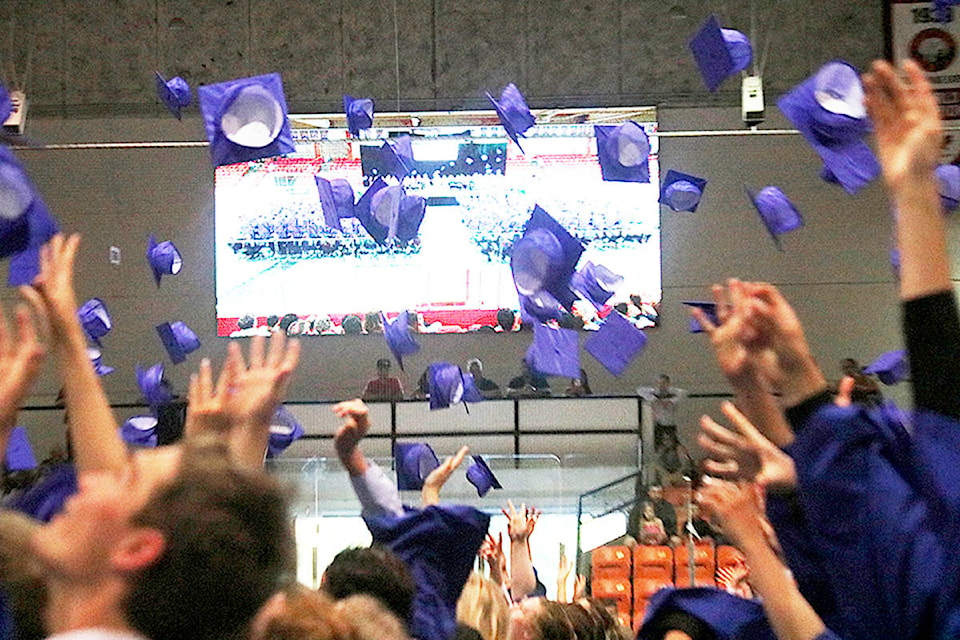It’s no small feat to reshape the culture of a school system, says Bill Ford from SD20 (School District 20).
But the upward trend of graduation rates - 93 per cent of all SD20 students graduated last year compared to the provincial average of 84 per cent - reflects the hard work of each and every person connected to the district over the past 10 years.
Because a decade ago, Ford says, the completion rate for all district students was much lower. And the divide was much wider for graduates with aboriginal ancestry and students identified with unique or special needs.
The latest numbers issued by the Ministry of Education show 88 per cent of students with aboriginal ancestry and 88 per cent of those with special needs graduated from SD20 in 2016/2017, compared to provincial rates of 66 per cent and 69 per cent respectively.
“In my second year here, the senior management team of the day went to the board and said we needed to start investing in kids and learning,” Ford told the Times, mentioning he has been with SD20 for 10 years.
“We needed to start investing in our teachers as learners, and despite all the cuts the school district was faced with over the last number of years, the board decided they would provide a budget to the senior management team to start attending to those downward trends, and we did that.”
Trustees took their lumps by making deep cuts, like closing Rossland Secondary School in 2013, but Ford says they added budget lines to improve education as a whole.
“That wasn’t always the most popular thing to do,” he continued. “But what happened was we embarked on a journey, we changed the culture of the school district.
“We are are now a school district that is focused on learning and not just student learning, but educator learning.”
Over the past number of years, the district pulled teachers together to talk about instructional practice, advanced learning opportunities and the students themselves.
“Because the kids that we see coming into schools these days are different than when I went to school,” said Ford. “Just the impact of technology alone, so that investment coupled with the fact that we have really supportive communities and families, we have seen the district evolve.”
The 93 per cent completion rate and the narrowing gap between graduates identifying as aboriginal and/or special needs, reflect positive changes made through tough decisions.
“It’s no small feat to change the culture of a school district, but we’ve managed to do that,” Ford said. “That’s everyone coming together from parents, custodians, and bus drivers … because we all play a role. We have so much to be excited about, and so much to be proud of, all of us.”
The completion rates for 2016/2017 in all B.C. public school are available online at bced.gov.bc.ca.
Ford says one clear message he’s repeatedly heard at professional gatherings is, “this ministry is paying attention to one critical piece of sector performance data, completion rates.”
From the ministry’s perspective, the effectiveness of a school system can be measured by the percentage of students that enter the system and then leave the system successfully graduating or ‘completing’.
The ministry has set lofty goals of getting as close to 100 per cent completion as possible, and to narrow the gap between non-Aboriginal and Aboriginal completion rates, as well as close the gap between students identified with special need and those without, he explained.
Completion rates in B.C. are calculated as the percentage of students who graduate with a Certificate of Graduation or Adult Graduation Diploma within six years from the first time they enrol in Grade 8. District-level results are adjusted for student migration in and out.
“We are not perfect and we still have challenges just like 59 other school districts in the province,” Ford added. “But with this particular news when it came out last week, (I think) we need to stand up and say we’ve done good work, are doing good work, and our kids are being served well by the school district.”
Elsewhere in the region, completion rates were not as high. According to the ministry’s latest numbers, 69 per cent of all students in School District 8 Kootenay Lake graduated last year, and 74 per cent of all students in SD10 Arrow Lakes.
